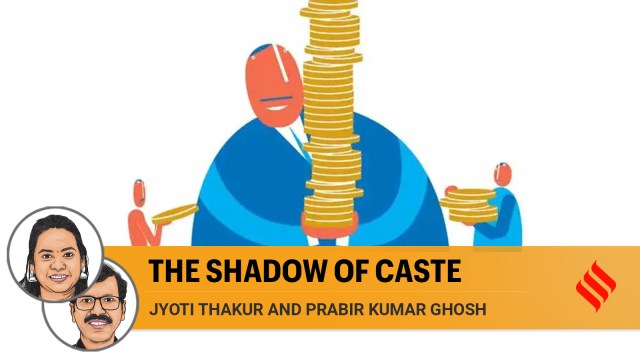
A recent working paper of the World Inequality Lab has reignited discussion on the widening gap between the rich and poor. Inequality in India, however, transcends the dichotomy between the haves and the have-nots, as caste-based inequalities are among the defining features of the country’s socioeconomic framework. Metrics like the Gini coefficient and percentile ratio serve as crucial tools for assessing economic inequality. By examining these metrics for the periods of 2017-18 and 2022-23, we explored the changes in consumption inequality both overall and within social groups such as the Scheduled Tribes (ST), Scheduled Castes (SC), Other Backward Classes (OBC), and the General category using the Periodic Labour Force data.
In 2022-23, while STs accounted for 9 per cent of the population, their consumption share stood at only 7 per cent. Similarly, SCs constituted 20 per cent of the population and their consumption share was 16 per cent. The OBCs (43 per cent of the population) aligned closely with their consumption share of 41 per cent — it still indicates a relatively more conservative consumption pattern within this group. Despite constituting 28 per cent of the population, the General category commanded a notably higher consumption share of 36 per cent. These findings underscore the persistent disparities in the distribution of consumption across various social groups. Despite minimal fluctuations over time, SCs and STs consistently lag behind people from the General and OBC categories.
The overall Gini coefficient decreased from 0.359 in 2017-18 to 0.309 in 2022-23, indicating a reduction in overall income inequality during this period by 0.050. The ST category saw its Gini coefficient decrease from 0.322 to 0.268, a 0.054 point drop, signalling improvement in the equitable distribution of consumption within this community. Similarly, the SC category observed a decrease from 0.312 to 0.273.
The OBC category witnessed a decline in the Gini coefficient from 0.336 to 0.288, a 0.048 point decrease, while the General category saw the most substantial reduction, from 0.379 to 0.306, amounting to a 0.073 point drop. This notable decrease in the latter could be indicative of various socioeconomic changes, including social mobility and effective policy interventions.
Nonetheless, digging deeper into consumption patterns reveals underlying economic disparities among India’s social groups, where ST and SC communities endure the most pronounced discrepancies. For ST, SC, and OBC groups, there’s a decrease in consumption levels from 2017-18 to 2022-23, albeit marginally for the bottom 20 per cent decile. However, for the General category, the decrease in consumption levels is more pronounced, indicating a relative decline in consumption among the poorest segment of the general population.
Conversely, consumption has slightly increased for all social groups in the top 20 per cent decile, with the General category experiencing a significant 10 percentage points surge between the two periods under analysis. This disproportionate rise among the wealthiest segment of the General category implies a potential concentration of wealth among high-caste elites. Consequently, the disparity between the General category and other social groups remains significant, underscoring persistent discrepancies in consumption patterns.
India has made remarkable strides in lifting millions out of multidimensional poverty, yet inequality among various caste groups persists. Despite the Constitution’s abolition of caste discrimination and the launch of affirmative action programmes, the shadow of caste continues to shape economic realities.
The Centre has enacted numerous policies to mitigate these disparities, including reservation, rural development initiatives, and direct benefit transfers. While these measures have yielded some progress in narrowing the gap, substantial challenges remain.
Disparities in consumption patterns among different socioeconomic groups reflect potential disparities in income, access to resources, or purchasing power. Efforts should concentrate on augmenting income generation and consumption abilities among the lower deciles, particularly within the ST and SC communities. This is also essential for fostering social harmony and economic stability across society. Continued monitoring of trends and targeted interventions addressing specific socio-economic challenges faced by different groups are necessary to ensure sustained progress towards greater economic equity.
Thakur is associate fellow and Ghosh is senior fellow at National Council of Applied Economic Research, New Delhi
Click here for real-time updates on the Lok Sabha Election Results 2024


